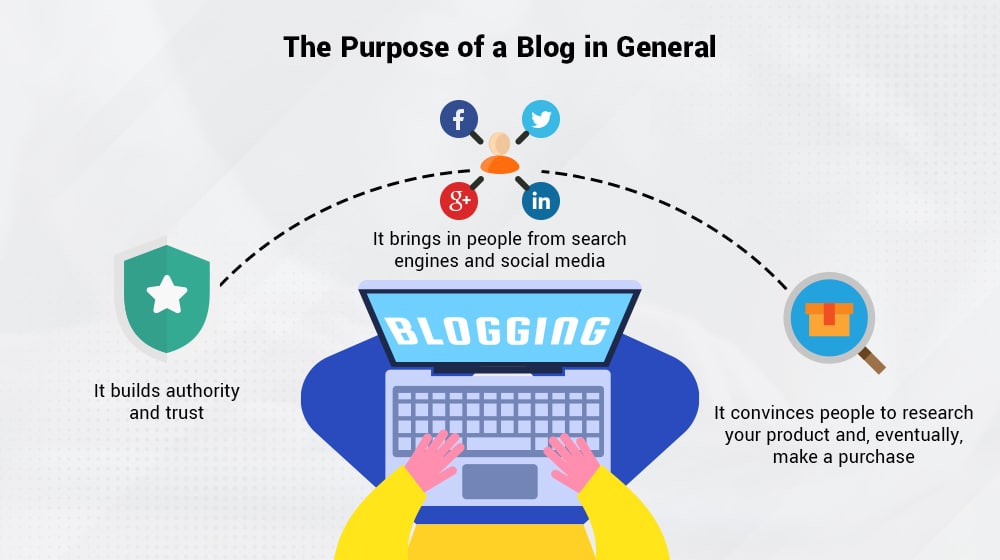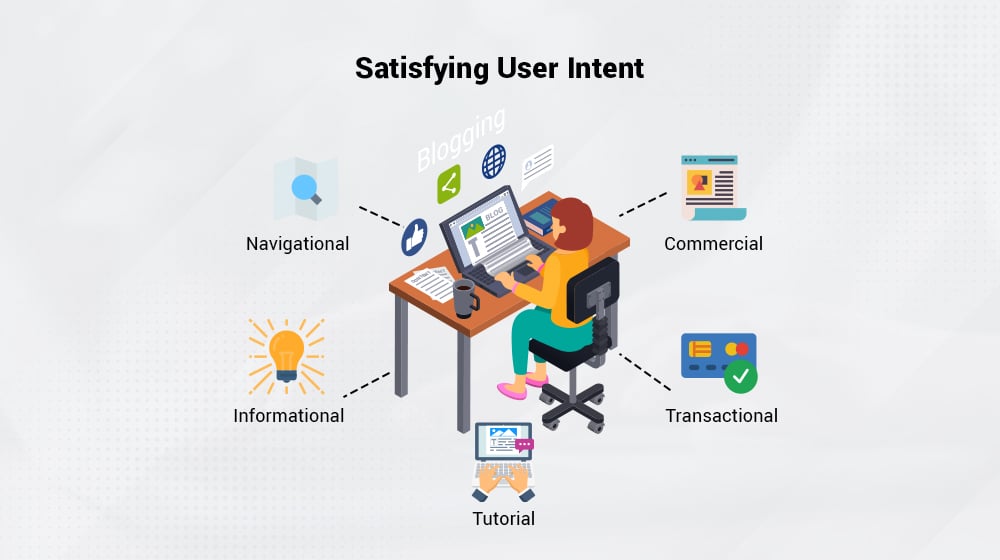One of the most common pieces of advice for any business is to start a blog, but what's the point? Blogs have a purpose, but it takes familiarity with marketing to understand that purpose and to implement it properly.
Consider this post a crash course to get you on the right track. Let's dig in!
A blog for a business exists for three main reasons.
First, it builds authority and trust. Your blog is a platform you can use to create content that shows off your expertise in your subject. A plumber's blog is about common plumbing issues and how to solve them, the purpose of plumbing tools, and the importance of certain kinds of connectors. People who read the blog can see that the person who owns it is an expert in their subject, and that fosters trust.

Modern SEO is heavily dependent on trust. In fact, Google puts a large emphasis on what they call E-A-T: Expertise, Authoritativeness, and Trustworthiness. A blog's primary purpose is to foster those elements of trust and differentiate a trustworthy site from a site that scrapes content or sells sub-par products.
Second, it brings in people from search engines and social media. Google has 90% of the market share for search, and a huge majority of people find the content they see online through Google. They do it through organic search, discovery feeds, and so on. Those who don't find content through Google search find it through social media feeds, and the people who post it on social media are either people sharing it from their own feeds, from their own searches, or are the brands themselves.
You need content if you want to be found online. The more blog posts you have, the more chances you have that people will be looking for a topic you cover. In a way, every single post you publish is an opportunity to be seen and for people to interact with you.
Third, it convinces people to research your product and, eventually, make a purchase. Blog posts aren't just for the top of the sales funnel; they exist at all stages of the funnel. People who have no idea what your brand even does will find your blog posts when they're researching a relevant topic. At the same time, experts who know what they need can also find your blog posts. They build trust in your brand, and when it comes time for them to make a purchase, you're the name on the tip of their tongue.
So, what's the purpose of each blog post on an individual level?
Each and every blog post needs to have a purpose. After all, without a purpose, why would you write it?
The purpose of a blog post is to satisfy the intent of a user, and that means knowing what user intent can be. So, here are the main types of user intent.

1. Navigational. Navigational intent is a kind of web search people make when they want to visit a specific page or brand site and are generally just looking for a homepage rather than a blog post or other content. Think typing "Netflix" into Google to go to Netflix.com. Blog posts won't help with this kind of intent since it's usually meant to find your homepage.
2. Informational. Informational intent is when a user wants to learn about a topic. Maybe they have a problem they want to solve, maybe they have a question they want to be answered, maybe they heard about your brand, and they just want to look into who you are.
Informational intent is among the most common targets for blog posts. If a user searches for "what is this caterpillar on my tomato plants," they'll find a bunch of blog posts about tomato hornworms, what they are, and what to do about them. The user wants information, and that can lead to further investigation into how to deal with a pest, but the primary intent of the search is to learn about a topic. They don't necessarily want to take action, and they probably aren't going to spring for a purchase, but it's an opportunity to do things like:
This further reading is one of the more important aspects of a blog post. It typically takes the form of internal links, often to other blog posts but sometimes to landing pages or product pages. Your "this is a tomato hornworm" page can lead to a page about how to help a plant recover from one, how to handle an infestation, and products you sell for dealing with them. The core blog post doesn't cover any of those things except in passing, but it provides a gateway to get people to read more.
3. Tutorial. Tutorial intent is the next step in an investigative process, and it's equally available to users who are searching for instructive content directly and people who searched for informational content and want to move on to the next step.
Tutorial content, as you might expect, is instructive. It tends to take one of two forms.
The goal of this kind of content is to provide a resource for a user, often with a call to action to simplify the process by using your product or service.
4. Commercial. The next step in the process for a sales funnel is commercial intent, or "consideration" intent. This is when a user knows they have a problem that needs solving, and they know there are products that can solve that problem, so they're researching their options.
Blog posts that target this intent are often product reviews and comparison pages. You'll see "the seven best toolkits for computer repair" with seven options for a user who has a computer they need to fix, and the post will give them options. They'll see comparisons between your product and products you choose to review that are tangibly worse to make your own look better.
The downside of commercial intent blog posts is that they are difficult to construct in a way that feels genuine. They need to come across as objective and unbiased, which is hard when you're promoting your own products. This is why they often end up as landing pages instead of blog posts, though both work.
5. Transactional. The final form of user intent is transactional. This is when a user knows they want to buy your product and are searching for that product to buy. There are several outcomes to this search; they might look for your product as available cheaper from other stores, they might look for coupons and deals related to the product, or they might just end up on your product page. It's also possible that they'll be looking for different versions.
This is, most often, not a job for blog posts. It's usually more for landing pages and product pages.
 So, as you can see, blog posts usually encompass informational and tutorial intent, with forays into other intents when it's viable to do so. That means the vast majority of your blog posts should be instructive or informational; they teach people about a subject, and they instruct people on how to solve problems. Anything beyond that is best addressed by another kind of content.
So, as you can see, blog posts usually encompass informational and tutorial intent, with forays into other intents when it's viable to do so. That means the vast majority of your blog posts should be instructive or informational; they teach people about a subject, and they instruct people on how to solve problems. Anything beyond that is best addressed by another kind of content.In addition to understanding what the user is searching for so you can write content for them, you also need to understand the audience themselves. It's not just about what they're searching for; it's about who they are.

For example: if a user has a computer that died, and they're searching for their symptoms, which of these pieces of content works best?
The answer is: it depends!
The trick is that all three of these are valid, and they are not mutually exclusive. The first post can even link to the second one and the third one because they serve as filters. Anyone from the third audience who lands on the first page will recognize that the content isn't for them but will be able to identify links to the content that is for them.
 It's a perfectly valid – and even recommended – technique to create all three pieces of content as an interlinked guide.
It's a perfectly valid – and even recommended – technique to create all three pieces of content as an interlinked guide.Bringing things back around, we can address the first question once again. Do blogs, in general, have a purpose? Yes, of course. They exist as a way to bring new users into your orbit, where they can be enticed closer and closer to the center, where the "center" is a purchase.

So, does each blog post need a purpose?
 Yes, and one of the main things that differentiates novice bloggers from experienced marketers is being able to identify and specify that purpose and express it within the content.
Yes, and one of the main things that differentiates novice bloggers from experienced marketers is being able to identify and specify that purpose and express it within the content.A blog post needs to match the intent of a user and the user's knowledge level, so it can become a perfect piece of content for them. A good blog, and a business running a good blog, should know their audience and their potential audiences. They can leverage this information to expand their area of influence and bring more people into their fold, get more people to sign up for their mailing list, and eventually convert more customers.
The key with blogging is that this is a lengthy process. Most of the time, your audience doesn't have an immediate, pressing need to make a purchase. They're curious, they're interested in a topic, or they saw something compelling on social media, and they're learning. You're simply keeping them engaged and pulling them in. Over time, they can be converted into customers, but that's the key: time. That's why blogs are run on an ongoing basis and why old content can still serve a purpose.
We encourage you to share this article on Twitter and Facebook. Just click those two links - you'll see why.
It's important to share the news to spread the truth. Most people won't.